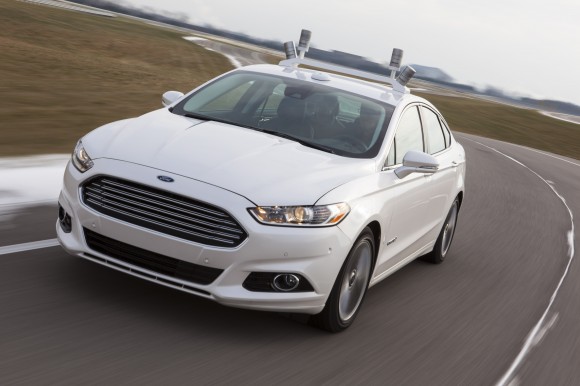Ford Motor Co. said on Wednesday it is joining with two top U.S. universities to launch research into automated driving technology.
The automaker said it will work with Stanford University and the Massachusetts Institute of Technology (MIT) on the “technical challenges” facing autonomous vehicles, which use automated systems to take over some driving functions.
Mark Fields, Ford’s chief operating officer, made the announcement at the opening of the annual Washington Auto Show, where the company showed off its automated Ford Fusion Hybrid research car.
“In the long term, we see a future of connected cars that communicate with each other and with the world around them to improve safety, reduce traffic congestion and achieve major environmental benefits,” Fields said. “It is likely to bring fully autonomous navigation and parking.”
The research car, Fields said, can operate on its own with the supervision of a driver. Loaded with technology that operates much like a bat or dolphin using sound waves, the car can sense moving objects including pedestrians, cars and animals.
Ford said the MIT research will focus on ways to predict the actions of other vehicles and pedestrians, which would enable to vehicle to plan a safe path avoiding those objects.
The Stanford research will explore how a vehicle might maneuver to allow sensors to “see” around obstructions.
The research is aimed at providing the vehicle with human-like common sense on the road to make driving safer.
“Drivers are good at using the cues around them to predict what will happen next and they know that what you can’t see is often as important as what you can see. Our goal in working with MIT and Stanford is to bring a similar type of intuition to the vehicle,” said Greg Stevens, Ford’s global manager for research in driver assistance and active safety.
The company did not disclose how much money it is spending the research.
Ford predicts that fully automated driving, alternative fuel vehicles and vehicle-to-vehicle communications will be a huge part of transportation’s future, and said it is investing in technologies, business models and partnerships to get there by 2025.
“Our goal is to offer a level of technology in which a driver is still in control and still able to enjoy the driving experience, but in a better, safer and more efficient way,” Fields said.
Ford shares were up 0.7 percent at $16.53 in afternoon trading on the New York Stock Exchange.
Topics Auto Autonomous Vehicles
Was this article valuable?
Here are more articles you may enjoy.



 State Farm: Catalytic Converter Thefts Drop 74%
State Farm: Catalytic Converter Thefts Drop 74%  Home Insurance Customers Staying Put Despite More Shopping Around: J.D. Power
Home Insurance Customers Staying Put Despite More Shopping Around: J.D. Power  How Big Was the Cat? Investigator Warns About Claims of Clogged Toilets
How Big Was the Cat? Investigator Warns About Claims of Clogged Toilets  Sentry Buys Nonstandard Auto Insurer The General From American Family for $1.7B
Sentry Buys Nonstandard Auto Insurer The General From American Family for $1.7B 

